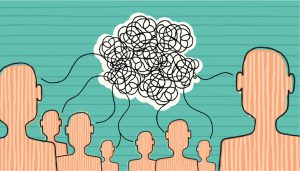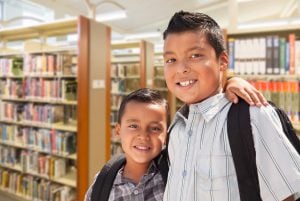 |
 Mark Oronzio suggests concept-mapping strategies for language learners
Mark Oronzio suggests concept-mapping strategies for language learners
For more than 40 years, education researchers have advocated the use of concept mapping as an effective approach to fostering higher-order thinking skills, moving students from mere knowledge acquisition to knowledge utilization and creation (Novak and Cañas, 2008). By specifying and linking concepts in a concept map, students and language learners create a visible structure of their understanding in a given domain that can be modified over time to assimilate new concepts and reflect new understanding.
In short, concept mapping can move learners toward more in-depth learning, i.e., more meaningful learning, by facilitating the process of linking new concepts with existing knowledge and experience. Concept mapping is an effective strategy for educators to use to support English language learners (ELLs) and prepare them for success in school and beyond.
There are several research-based methods for applying concept mapping to language learning. Here are some of the ways teachers can use concept mapping to differentiate instruction for ELL students:
Pre-Reading
• Invite students to share what they already know about a particular concept in a concept map prior to reading. This approach provides students with the concepts and words that they are about to encounter in the reading text as well as an overview of the content to be learned. Then, ask students to add information to their maps while reading to provide a visual aid for building on their prior knowledge. This could be an individual or whole-class assignment.
Pre-Writing
• Task students with brainstorming about a given topic by making connections among ideas and analyzing information in a concept map in preparation for writing. Allow students to discuss their maps in groups and share their ideas for writing so they can hone or expand their focus as needed. After researching their topic, students can modify their maps to capture new information and organize their thoughts before writing their compositions. Research has shown that this approach helps ELL students improve their writing.
Vocabulary Building
• Enable students to create concept maps to define and better understand key vocabulary terms. Students can access videos, text, and images to learn about a term and then build a map that visually links the term to its various meanings, uses, related words, synonyms, and more. This allows students to personalize their connections to the vocabulary words, improving their recall and comprehension. The map provided in this post is an example of this approach.
Developing Critical Thinking
• Encourage students to create a concept map of a unit or topic with key terms and essential questions during and after a series of lessons. Help them to see the big picture of the topic as well as build a scaffolding of meaning, a governing framework for future success, by emphasizing the main ideas, key concepts, and principles.
By visually expressing the association of related concepts, concept maps help learners to find unseen connections between ideas, organize information easily, and create new knowledge, which in turn clarifies their thinking. This process of making knowledge explicit fosters the understanding of complex information for ELL students without elaborative written explanations. The concept maps are also useful visual aids that make later study and recall easier for language learners than with linear notes.
Assessment
• Use concept maps to ascertain student understanding of a concept or unit taught. By making students’ thinking and learning visible, concept maps reveal to teachers, and to the students themselves, the gaps in understanding at any given moment. After reteaching or employing interventions, have students adjust their concept maps to assess their knowledge development over time.
Reading Comprehension
• Ask students to build a concept map as they read a book or text, identifying main ideas, finding subconcepts, and linking related ideas together. An earlier post on close reading strategies shows how this method can help all learners, particularly ELL/ESL students, improve reading comprehension. Try any of these methods with ELL students to help them develop content-area knowledge, literacy skills, and critical thinking, as well as to evaluate their learning needs and progress.
Additional Background
The Ideaphora concept-mapping environment is the latest and most comprehensive tool for facilitating critical thinking through web-based concept mapping. It builds on decades of research investigating the use of concept mapping as an effective approach to fostering meaningful learning (Hilbert and Renkl, 2008; Novak and Cañas, 2008). In addition, it benefits from years of research experience designing and integrating technology-supported concept mapping in the classroom (Anderson-Inman and Ditson, 1999; Anderson-Inman and Horney, 1996/1997; Liu et al., 2010; Muirhead, 2006).
For more than 40 years, Novak and colleagues have advocated the use of concept mapping as an effective approach to fostering higher-order thinking skills, moving students from mere knowledge acquisition to knowledge utilization and creation (Novak and Cañas, 2008). By specifying and linking concepts in a concept map, students create a visible structure of their understanding in a given domain that can be modified over time to assimilate new concepts and reflect new understanding.
In short, concept mapping can move learners toward more in-depth learning, i.e., more meaningful learning, by facilitating the process of linking new concepts with existing knowledge and experience. Research on concept mapping reveals the process can have a powerful effect on learning. For example, Brullo (2012) found that students who created concept maps while taking notes had better test recall, could access information more quickly during tests, and scored better on content post-tests than students who did not have the concept-mapping experience.
According to Brullo, students who created concept maps were thinking on a deeper level about the text prior to taking the post-test, as these students quickly recalled information and answered the questions. Research also reveals that technology can play an important role in simplifying and supporting the creation, modification, and management of learners’ concept maps (Chang et al., 2002; Liu et al., 2006; Liu and Lee, 2013).
In 1956, Bloom proposed a taxonomy of intellectual behavior important for learning, with acquisition of knowledge at the bottom and evaluation of knowledge at the top. Decades of research on how to promote higher-order thinking skills has led to a revision of Bloom’s taxonomy and closer alignment with 21st-century learning goals (Anderson and Krathwohl et al., 2001). The lowest level of learning in the revised taxonomy is “remembering” existing knowledge, and the highest is “creating” new knowledge—a differentiation in skill level also found in the Common Core State Standards.
In response to the revised taxonomy, Mayer (2002) advocated moving from instruction that focuses on retention of learning (remembering and understanding) toward instruction that fosters transfer of learning (applying, analyzing, evaluating, and creating)—in other words, “meaningful learning.” Key to the concept of meaningful learning is the learner’s ability to link new ideas and information to prior experience and existing knowledge (Anderson-Inman and Ditson, 1999).
Mark Oronzio is CEO and co-founder of Ideaphora, a concept-mapping platform for students to improve their comprehension of digital content while building higher-order thinking skills. Oronzio’s insight and leadership is based on more than 20 years of experience in executive-level positions for education technology companies, including Inspiration Software.

 The recently released National K–12 Foreign Language Enrollment Survey Report shows that a total of 10.6 million U.S. students ranging from kindergarten to twelfth grade are studying a world language, accounting for only about 20% of U.S. school children.
The recently released National K–12 Foreign Language Enrollment Survey Report shows that a total of 10.6 million U.S. students ranging from kindergarten to twelfth grade are studying a world language, accounting for only about 20% of U.S. school children.

 President Trump has announced a new executive action restoring restrictions on travel and trade with Cuba, “I am canceling the previous administration’s completely one-sided deal,” he announced to an appreciative crowd of Cuban dissidents in Miami.
President Trump has announced a new executive action restoring restrictions on travel and trade with Cuba, “I am canceling the previous administration’s completely one-sided deal,” he announced to an appreciative crowd of Cuban dissidents in Miami.
 A new
A new 
 Mark Oronzio suggests concept-mapping strategies for language learners
Mark Oronzio suggests concept-mapping strategies for language learners
 Rene Gadelha believes that only careful implementation will realize the promise of virtual reality in education
Rene Gadelha believes that only careful implementation will realize the promise of virtual reality in education Keith Oelrich argues that teacher preparation and curriculum design are the keys to closing the digital technological opportunity gap
Keith Oelrich argues that teacher preparation and curriculum design are the keys to closing the digital technological opportunity gap




